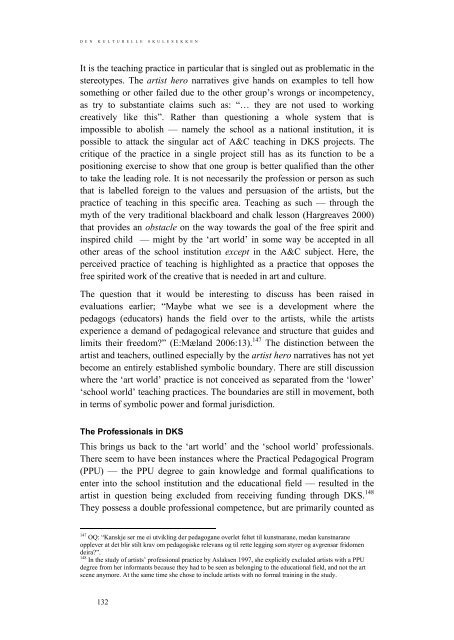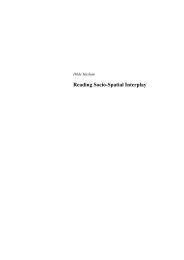CON ⢠TEXT - Arkitektur- og designhøgskolen i Oslo - AHO
CON ⢠TEXT - Arkitektur- og designhøgskolen i Oslo - AHO
CON ⢠TEXT - Arkitektur- og designhøgskolen i Oslo - AHO
- No tags were found...
You also want an ePaper? Increase the reach of your titles
YUMPU automatically turns print PDFs into web optimized ePapers that Google loves.
D E N K U L T U R E L L E S K U L E S E K K E NIt is the teaching practice in particular that is singled out as problematic in thestereotypes. The artist hero narratives give hands on examples to tell howsomething or other failed due to the other group’s wrongs or incompetency,as try to substantiate claims such as: “… they are not used to workingcreatively like this”. Rather than questioning a whole system that isimpossible to abolish — namely the school as a national institution, it ispossible to attack the singular act of A&C teaching in DKS projects. Thecritique of the practice in a single project still has as its function to be apositioning exercise to show that one group is better qualified than the otherto take the leading role. It is not necessarily the profession or person as suchthat is labelled foreign to the values and persuasion of the artists, but thepractice of teaching in this specific area. Teaching as such — through themyth of the very traditional blackboard and chalk lesson (Hargreaves 2000)that provides an obstacle on the way towards the goal of the free spirit andinspired child — might by the ‘art world’ in some way be accepted in allother areas of the school institution except in the A&C subject. Here, theperceived practice of teaching is highlighted as a practice that opposes thefree spirited work of the creative that is needed in art and culture.The question that it would be interesting to discuss has been raised inevaluations earlier; “Maybe what we see is a development where thepedag<strong>og</strong>s (educators) hands the field over to the artists, while the artistsexperience a demand of pedag<strong>og</strong>ical relevance and structure that guides andlimits their freedom?” (E:Mæland 2006:13). 147 The distinction between theartist and teachers, outlined especially by the artist hero narratives has not yetbecome an entirely established symbolic boundary. There are still discussionwhere the ‘art world’ practice is not conceived as separated from the ‘lower’‘school world’ teaching practices. The boundaries are still in movement, bothin terms of symbolic power and formal jurisdiction.The Professionals in DKSThis brings us back to the ‘art world’ and the ‘school world’ professionals.There seem to have been instances where the Practical Pedag<strong>og</strong>ical Pr<strong>og</strong>ram(PPU) — the PPU degree to gain knowledge and formal qualifications toenter into the school institution and the educational field — resulted in theartist in question being excluded from receiving funding through DKS. 148They possess a double professional competence, but are primarily counted as147 OQ: “Kanskje ser me ei utvikling der pedag<strong>og</strong>ane overlet feltet til kunstnarane, medan kunstnaraneopplever at det blir stilt krav om pedag<strong>og</strong>iske relevans <strong>og</strong> til rette legging som styrer <strong>og</strong> avgrensar fridomendeira?”.148 In the study of artists’ professional practice by Aslaksen 1997, she explicitly excluded artists with a PPUdegree from her informants because they had to be seen as belonging to the educational field, and not the artscene anymore. At the same time she chose to include artists with no formal training in the study.132
















